Definition, Formulas and examples of the Constant Velocity Motion
This article will be about The constant velocity motion with formulas and how to solve problems, and the main characteristics of this type of motion.
Characteristics of a constant velocity motion
The constant velocity motion is a motion that has as a trajectory a straight line and a constant velocity. That a body is moving at a constant velocity means that there is no force or acceleration that is forcing him to move, this is why a body in a constant velocity motion the acceleration is null.
There are a lot of examples in everyday life where we can appreciate a constant velocity motion, for example the motion of a train, a car that is going on a straight road, or a person that walks at the same velocity without any acceleration.
Use of a constant velocity motion
Knowing the formulas and characteristics of a constant velocity motion is pretty useful to measure an average velocity, in normal situations could be a little complicated to measure the velocity of an object if we don´t have any special instruments, but if we know the distance the object advanced (that could be measured with a measuring tape) and the time that took the object to move that distance (that could be measured with a clock or a phone) we can use the study of this motion to find the velocity without the need of any special instrument. We say “an average velocity” because in everyday life it could be complicated to find a constant velocity, for example, if a person walks 5 meters in 5 seconds, it is really hard that this person had have walked at the exact same velocity all the time, because it is possible that some steps where bigger than other, and this, even though is a millimeter difference, counts, and this makes the motion not constant, but the average motion calculated on a constant velocity motion is highly correct.
Formulas of the constant velocity motion
In the constant velocity motion there are 3 physical magnitudes which we are going to work with, this are the time, that could be measure in seconds, minutes, hours or even days; the distance, that could be measured in meters, kilometers and miles; and the velocity, that could be measured in meters per second, kilometers per hours, miles per hour or any other combination between distance and time. The velocity in a constant velocity motion is the relation between the time and the distance, for example if a car moves 10 meters every second, then the velocity of the car is 10 meters per second. Normally in kinematic problems we are going to work as the standard units of measure the meters and seconds, but it does not affect anything at all if we work with other unit of measure, as long as all the physical magnitudes are equivalents between each other, but in the examples solved in this article we are going to use meters and seconds.
- Constant velocity motion formulas
- V = DT
- T = DV
- D = V * T
- ó
- X = Xo + V * T
Triangle of formulas
A very easy way to remember this formulas is by building a triangle. This triangle works the following way: when we cover the variable that we want to find, we can see the formula that we have to use, when there is a variable on top of the other, these are divided, and if two variables are next to each other these will be multiplied, remembering that the distance is always on top of the triangle.

Graphics of a constant velocity motion
Position graphic: it is a lineal graphic where the slop of the graphic is the velocity of the object.
Velocity graphic: is a constant graphic, this means that is a line without a slope.
Examples of Constant velocity motion
Example 1 A vehicle that travels to a constant velocity of 20 m/s ¿How much distance did the vehicle traveled in 30 seconds?
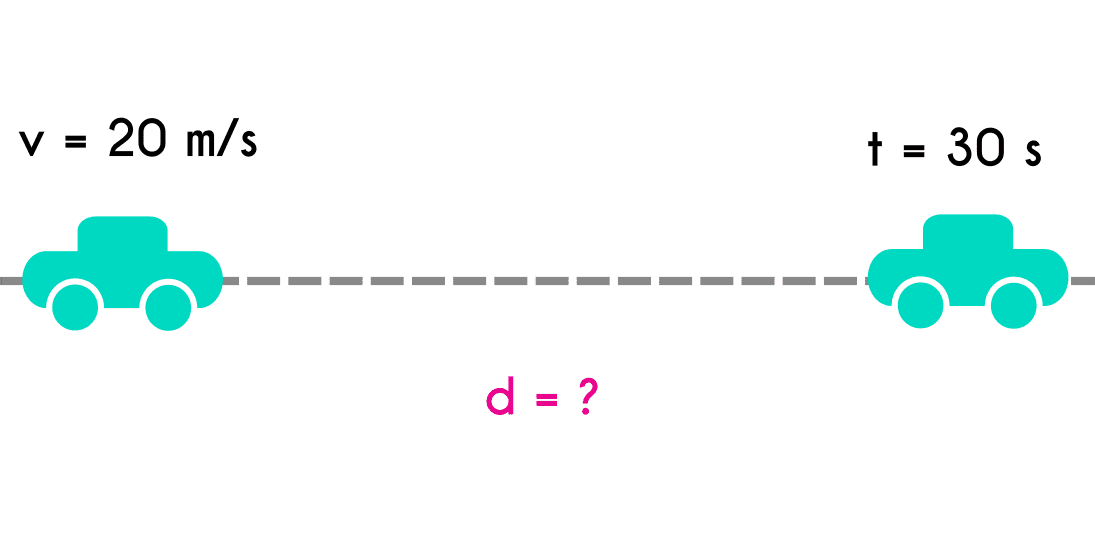
v = 20m/st = 30s d = ?
- We write the formula
- D = v * t
- We replace the data
- D = 20 m/s * 30 s
- and solve
- D = 600 m
Example 2 A train advanced 30 meters in 2.4 seconds, if this train has a constant velocity ¿What was the velocity of the train?
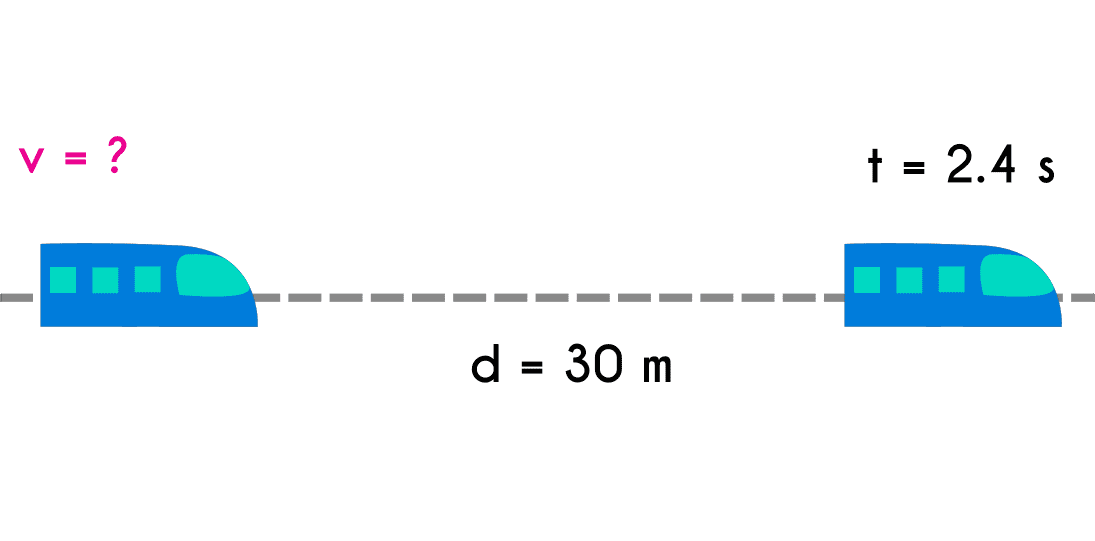
d = 30mt = 2.4s v = ?
- Write the equation
- V =
dt
- And solve
- V =
30m2.4s
- V = 12.5 m/s
Example 3 how long did it take to an olympic runner to run 100 meters if he started with a constant velocity of 12.3 m/s.
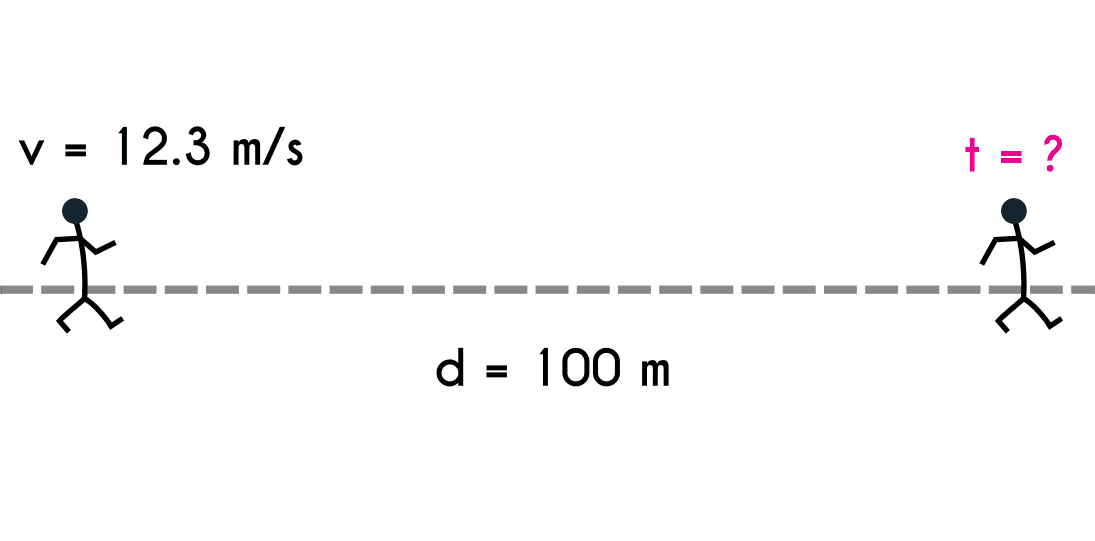
d = 100mv = 12.3m/s t = ?
- Write the equation
- V =
dv
- And solve
- V =
10012.3
- T = 8.13 s
Example 4 A whale has to emigrate 10 kilometers east, if the whale has to be at its destination in 24 hours, define the velocity that the whale has to have to get there on time.
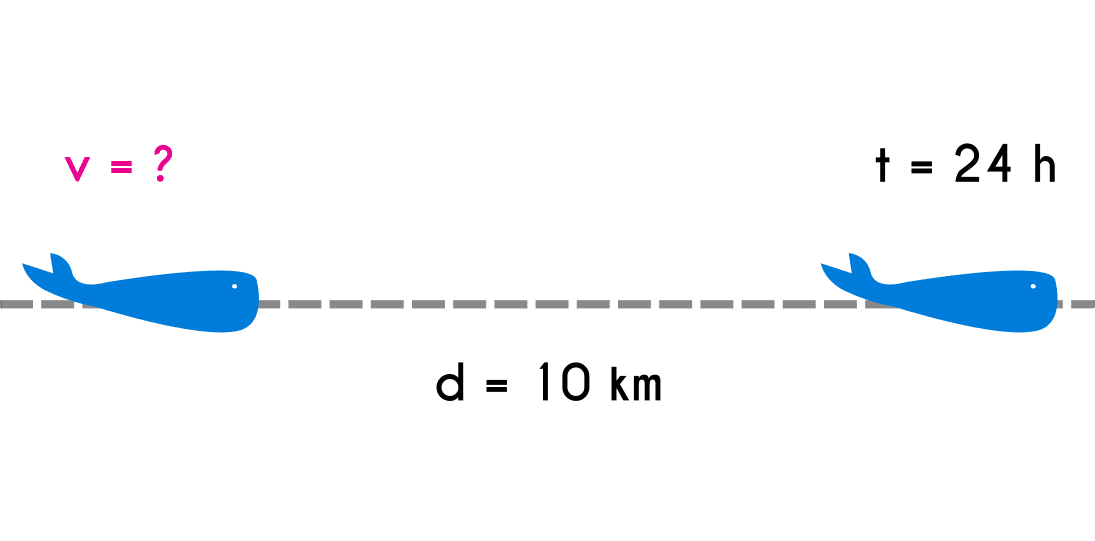
d = 10kmt = 24h v = ?
Important the first thing we have to do is convert the km into meters and the hours into seconds
- From km to m
- D = 10 km * 1000
- D = 10 000 m
- From h to s
- T = 24 h * 3 600
- T = 86 400
- Then we write the equation and solve
- V =
dv
- V =
10 000 m86 400s
- V = 0.12 m/s
Example 5 There are two men that practice race walk, the A man covers a distance of 37 meters in 12.5 seconds, while the B man covers a distance of 44 meters in 19.r meters, knowing this, define which of the two men is faster.
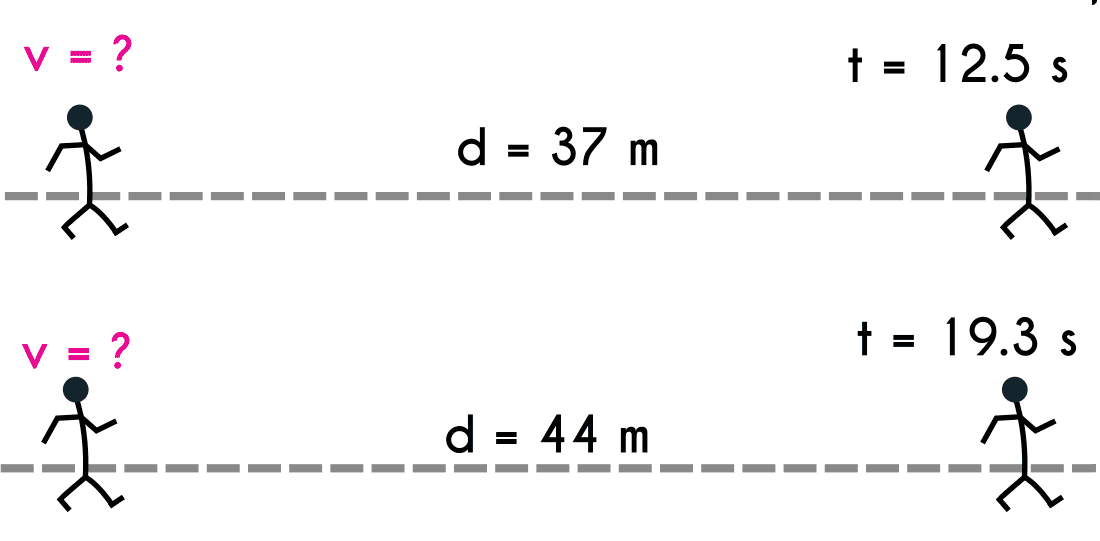
Man a: d = 37mt = 12.5s v = ?
- Man a
- V =
dv
- V =
37m12.5s
- V = 2.96 m/s
Man b: d = 44mt = 19.3s v = ?
- Man b
- V =
dv
- V =
44m19.3
- V = 2.28 m/s
In conclusion, the a man is faster then the b man.
Ejercicio 6 two cars make different tours, the first car travels 400 meters at a speed of 10m/s, while the second car travels 700 meters at a velocity of 16.3 m/s, which of the cars took the shorter to get to the final point.
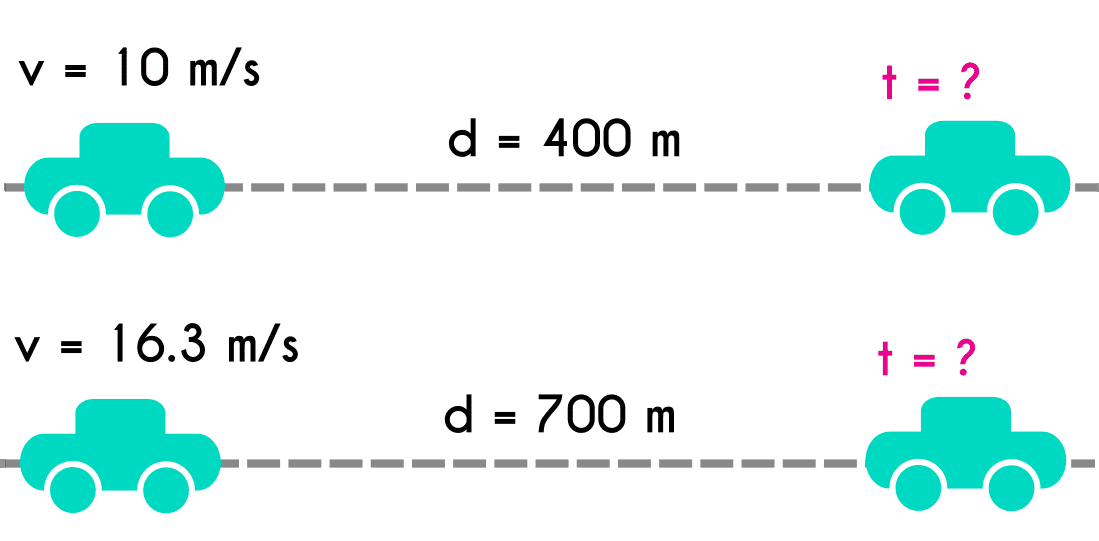
car 1: v = 10 m/sd = 400 m t = ?
- car 1
- T =
DV
- T =
400m10m/s
- t = 40 s
car 2: v = 16.3 m/sd = 700 m t = ?
- car 2
- T =
DV
- T =
700m16.3m/s
- t = 42.94
Example 7 A person prepares for a marathon by running an hour at a velocity of 3 m/s every day ¿what is the distance that this person covers in 10 days?
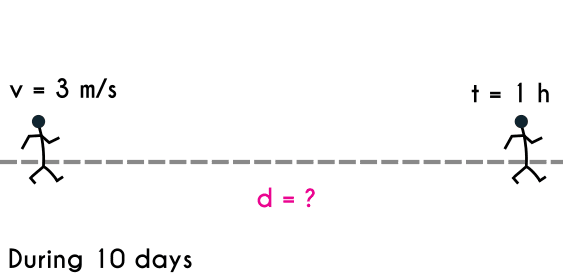
v = 3 m/st = 1 h durante 10 días d = ?
- Convert the hours into seconds
- t(seconds)= 1h * 60 * 60
- t = 3600 seconds
- Now we find the distance in in 1 hour
- d = v * t
- d = 3m/s * 3600s
- d = 10 800m
- Then we multiply it by 10 days
- d(10 days) = 10 800m * 10
- d(10 days) = 108 000 meters
Example 8 a train travels at a velocity of 20 meters per second on straight rails, calculate the covered distance after 10, 25 and 60 minutes.
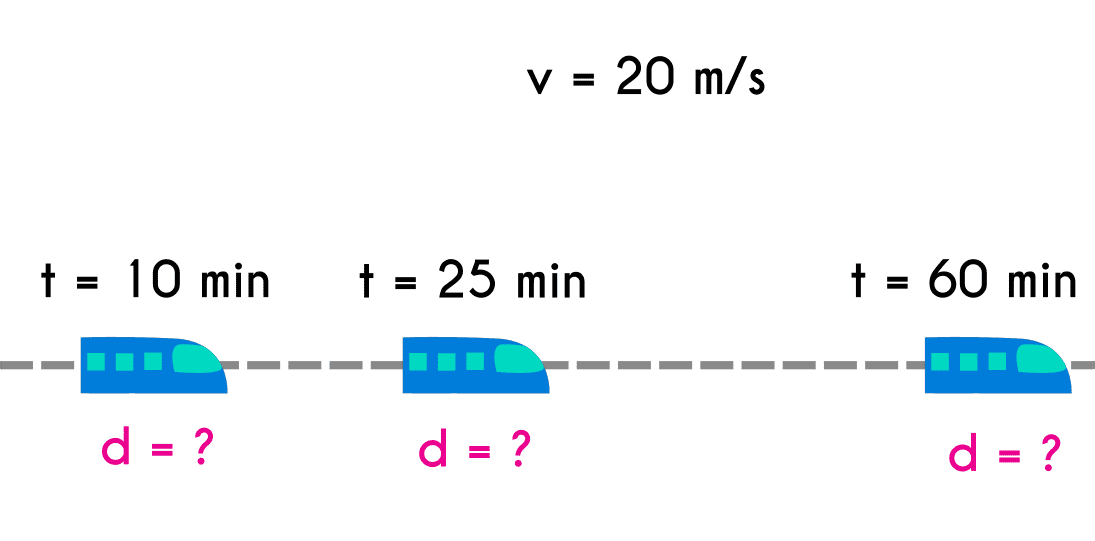
v = 20 m/st = 10min, 25min, y 60 min d = ?
- Distance after 10 minutes
- t(seconds)= 10 min * 60 seconds
- t = 600s
- d = v * t
- d = 20m/s * 600s
- d = 12 000 meters
- Distance after 25 minutes
- t(seconds)= 25 min * 60 seconds
- t = 1 500s
- d = v * t
- d = 20m/s * 1 500s
- d = 30 000 meters
- Distance after 60 minutes
- t(seconds)= 60 min * 60 seconds
- t = 3 600s
- d = v * t
- d = 20m/s * 3 600s
- d = 72 000 meters